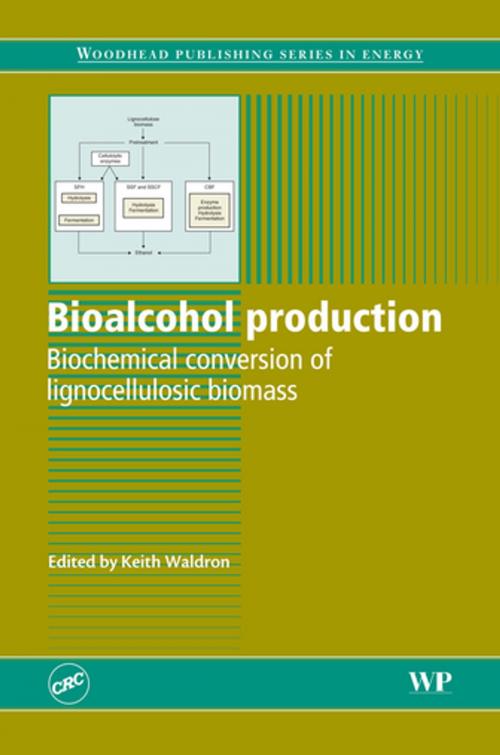Bioalcohol Production
Biochemical Conversion of Lignocellulosic Biomass
Nonfiction, Science & Nature, Technology, Petroleum, Power Resources| Author: | ISBN: | 9781845699611 | |
| Publisher: | Elsevier Science | Publication: | May 24, 2010 |
| Imprint: | Woodhead Publishing | Language: | English |
| Author: | |
| ISBN: | 9781845699611 |
| Publisher: | Elsevier Science |
| Publication: | May 24, 2010 |
| Imprint: | Woodhead Publishing |
| Language: | English |
Bioethanol is one of the main biofuels currently used as a petroleum-substitute in transport applications. However, conflicts over food supply and land use have made its production and utilisation a controversial topic. Second generation bioalcohol production technology, based on (bio)chemical conversion of non-food lignocellulose, offers potential advantages over existing, energy-intensive bioethanol production processes. Food vs. fuel pressures may be reduced by utilising a wider range of lignocellulosic biomass feedstocks, including energy crops, cellulosic residues, and, particularly, wastes.
Bioalcohol production covers the process engineering, technology, modelling and integration of the entire production chain for second generation bioalcohol production from lignocellulosic biomass. Primarily reviewing bioethanol production, the book’s coverage extends to the production of longer-chain bioalcohols which will be elemental to the future of the industry.
Part one reviews the key features and processes involved in the pretreatment and fractionation of lignocellulosic biomass for bioalcohol production, including hydrothermal and thermochemical pretreatment, and fractionation to separate out valuable process feedstocks. Part two covers the hydrolysis (saccharification) processes applicable to pretreated feedstocks. This includes both acid and enzymatic approaches and also importantly covers the development of particular enzymes to improve this conversion step. This coverage is extended in Part three, with chapters reviewing integrated hydrolysis and fermentation processes, and fermentation and co-fermentation challenges of lignocellulose-derived sugars, as well as separation and purification processes for bioalcohol extraction.
Part four examines the analysis, monitoring and modelling approaches relating to process and quality control in the pretreatment, hydrolysis and fermentation steps of lignocellulose-to-bioalcohol production. Finally, Part five discusses the life-cycle assessment of lignocellulose-to-bioalcohol production, as well as the production of valuable chemicals and longer-chain alcohols from lignocellulosic biomass.
With its distinguished international team of contributors, Bioalcohol production is a standard reference for fuel engineers, industrial chemists and biochemists, plant scientists and researchers in this area.
- Provides an overview of the life-cycle assessment of lignocelluloses-to-bioalcohol production
- Reviews the key features and processes involved in the pre-treatment and fractionation of lignocellulosic biomass for bioalcohol production
- Examines the analysis, monitoring and modelling approaches relating to process and quality control in pre-treatment, hydrolysis and fermentation
Bioethanol is one of the main biofuels currently used as a petroleum-substitute in transport applications. However, conflicts over food supply and land use have made its production and utilisation a controversial topic. Second generation bioalcohol production technology, based on (bio)chemical conversion of non-food lignocellulose, offers potential advantages over existing, energy-intensive bioethanol production processes. Food vs. fuel pressures may be reduced by utilising a wider range of lignocellulosic biomass feedstocks, including energy crops, cellulosic residues, and, particularly, wastes.
Bioalcohol production covers the process engineering, technology, modelling and integration of the entire production chain for second generation bioalcohol production from lignocellulosic biomass. Primarily reviewing bioethanol production, the book’s coverage extends to the production of longer-chain bioalcohols which will be elemental to the future of the industry.
Part one reviews the key features and processes involved in the pretreatment and fractionation of lignocellulosic biomass for bioalcohol production, including hydrothermal and thermochemical pretreatment, and fractionation to separate out valuable process feedstocks. Part two covers the hydrolysis (saccharification) processes applicable to pretreated feedstocks. This includes both acid and enzymatic approaches and also importantly covers the development of particular enzymes to improve this conversion step. This coverage is extended in Part three, with chapters reviewing integrated hydrolysis and fermentation processes, and fermentation and co-fermentation challenges of lignocellulose-derived sugars, as well as separation and purification processes for bioalcohol extraction.
Part four examines the analysis, monitoring and modelling approaches relating to process and quality control in the pretreatment, hydrolysis and fermentation steps of lignocellulose-to-bioalcohol production. Finally, Part five discusses the life-cycle assessment of lignocellulose-to-bioalcohol production, as well as the production of valuable chemicals and longer-chain alcohols from lignocellulosic biomass.
With its distinguished international team of contributors, Bioalcohol production is a standard reference for fuel engineers, industrial chemists and biochemists, plant scientists and researchers in this area.
- Provides an overview of the life-cycle assessment of lignocelluloses-to-bioalcohol production
- Reviews the key features and processes involved in the pre-treatment and fractionation of lignocellulosic biomass for bioalcohol production
- Examines the analysis, monitoring and modelling approaches relating to process and quality control in pre-treatment, hydrolysis and fermentation















